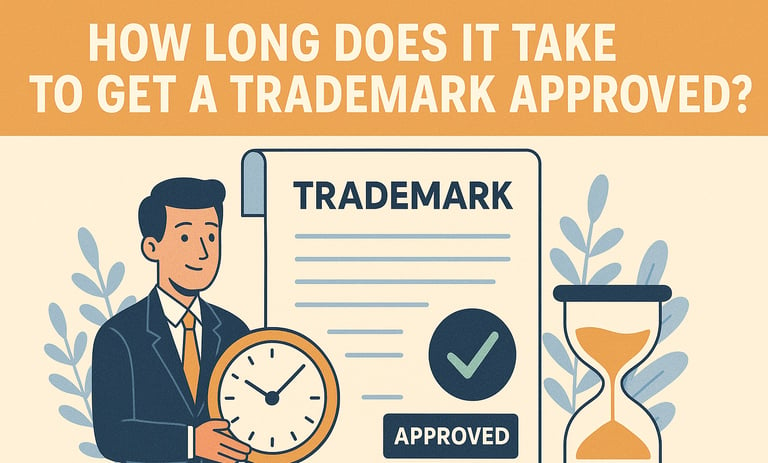How Long Does It Take to Get a Trademark Approved?
This article explores the timeline and process for trademark approval, detailing typical durations and factors that affect registration. It provides practical tips and country-specific insights to help businesses navigate the trademark application process efficiently.
IPRCORPORATE LAWS
Prajul
7/9/20253 min read


A trademark refers to the unique symbol, phrase, design, or word that facilitates distinguishing a company’s products or services from those of its competitors. To protect a brand identity and to prevent its unauthorized use, it is recommended to get the trademark registered. However, the whole procedure is a tough nut to crack, since it isn’t as instantaneous as it may sound and varies significantly depending on various influencing factors. To avoid unnecessary delays, one needs to understand the timeline and the factors influencing the business and plan in a better manner.
Understanding Trademark Approval Process
Several stages are involved in getting a trademark registered, these include: filing the trademark application, receiving an examination report by the publication office, publication for opposition, and finally, after that, registration and a certificate are issued. Each stage ensures that the trademark is distinctive and has no potential to confuse the customers between already existing marks and complies with the legal requirements.
Time taken to get a Trademark Approved?
Well, there is no specific timeframe within which a trademark gets approved since it is believed that the duration which is taken for a trademark to get approved highly depends on the complexity of the case, the jurisdiction under which the application has been filed and whether any objections or oppositions are raised regarding the applicant’s trademark or not. Generally, in many countries, the process usually takes between several months and two years.
There is no specific time to get it done; it differs case by case. In some countries, it may vary between several months to a period of two years, which is widely dependent upon the jurisdiction and specifics of the application as well. For instance, in the case of the USA, the United States Patent and Trademark Office (USPTO) generally takes between 8 to 18 months of time period in cases where there are no objections. While in India, it takes between 18 to 24 months in case of no objections, but it can extend up to a time period of 36 months or more if in case there are some hurdles or oppositions. In the European Union, the process usually takes a time period between 4 to 6 months in cases where there are no oppositions, but it can be further extended if oppositions exist.
Stages of trademark registration and their timeframes
The following are the stages that are part of the trademark registration process, and the timeframes involved:
Filing of the Application
The process begins with the submission of the application to the trademark office. Usually, an application number is assigned in just a few days.
Examination of the Report
Once the application has been filed, a trademark examiner then examines the application to check the legal compliance and requirements and look for any already existing trademarks that may be conflicting.
Publication and Opposition
In case the application passes the examination, then the mark is published in an official journal. However, third parties can still file opposition within a specific period, which may vary between one to four months.
Registration and Issuance of Certificate:
In a case where there is no opposition to the trademark, or if filed but is resolved at a later stage in Favour of the applicant, the trademark is registered, and thus a certificate is issued.
Common Causes for Delays
Several factors may cause a delay in the trademark approval process:
Legal disputes: In cases where the trademarks are challenged in court, the registration process may be put on hold until the dispute is resolved since it is time time-consuming procedure.
Objections and Oppositions: also, in cases where the trademarks face opposition from third parties for registration, the process can be delayed significantly, since an examination report has to be filed within one month from the date of the complaint, and the report is later examined, which ultimately causes a delay in the procedure.
Backlogs by Administration: When there are high volumes of applications, it may also slow down processing at the trademark office.
Protection and rights during the application Process
It is suggested that people should be aware of using the ® symbol until their trademark is officially registered; in the meantime, they can use the TM symbol to indicate the idea of claiming rights over the mark as soon as they apply.
Frequently Asked Questions
Can I use my trademark before getting approval?
Yes, one can use the trademark before getting approval with the TM symbol since the ® symbol can only be used once the trademark is officially registered.
How long does a trademark last?
Typically, a trademark lasts for 10 years and can also be renewed indefinitely, provided that the renewal fee is paid on time and the mark is in use.
What if someone opposes my trademark?
When an opposition is filed, the applicant is given time to respond and may need to engage in legal proceedings as well, which may cause a slight delay in the registration process.
In Conclusion, understanding the trademark approval process and its potential delays enables businesses to plan and protect their brand effectively. Seeking professional guidance and preparing thorough applications can significantly streamline the path to trademark registration.
